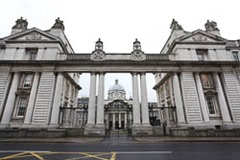Renewing the Civil Service
 The Civil Service Renewal Plan, published by the Department of Public Expenditure and Reform (DPER), sets out high ambitions for streamlining and changing how the organisation operates. eolas examines the main proposals.
The Civil Service Renewal Plan, published by the Department of Public Expenditure and Reform (DPER), sets out high ambitions for streamlining and changing how the organisation operates. eolas examines the main proposals.
Why renew?
Put simply: “We aim to be the best that we can be in everything we do.” The paper emphasises continuous improvement as the Civil Service adapts and responds to social, political, environmental and economic change.
Key challenges include a mixed record on implementation, its “often rigid” structures and processes, considerable variation in how departments invest in professional development, and an ageing workforce. That said, clear strengths were also identified e.g. a public service ethos, honesty and independence, the quality and objectivity of policy advice, and the ability to adapt to changing circumstances and priorities.
A single organisation
Many of the problems facing government are cross-cutting and therefore require joined-up thinking that focuses on outcomes. The accountability board will oversee how the Civil Service delivers on cross-cutting government objectives. Chaired by An Taoiseach, its members will be drawn from the Cabinet, Civil Service and external stakeholders.
At the top level of the Civil Service, a management board will be chaired by the Secretary General to the Government and comprise the other secretaries general. The management board will identify key outcomes for the year ahead and produce a business plan to achieve them and an overarching statement of strategy.
The Civil Service management board will review and challenge each draft statement of strategy – and ensure that statements take cross-cutting initiatives and the Programme for Government into account. Strategic horizon scans will identify long-term risks, challenges and opportunities i.e. 10 years ahead and longer. Shared services and professional networks will share expertise in areas such as project management and communications.
Maximising performance
A new strategic model for human resources will be developed by DPER, with a focus on leadership, consistency and sharing best practice. Recruitment and promotion processes will be opened up at all levels. A unified learning and development strategy will be based on an assessment of future skills requirements, updated through a regular skills audit. A core skills induction programme will be run for all new and newly promoted staff.
Each senior manager will undergo a development centre assessment for their strengths and areas for development. Talent management schemes will seek to promote future leaders and be accompanied by a stronger performance management process. An annual awards ceremony will recognise and celebrate success, particularly among teams, and an innovation lab will help to pilot and share new ideas across the Civil Service.
Responsiveness
A greater range of specialist skills is needed if the Civil Service is to respond better to national and global changes. Professional streams will therefore be established for human resources, ICT and financial management while the existing streams for legal services, audit, statistics and economics will be formalised.
All career mobility, secondment and transfer opportunities will be advertised through a single portal. Managers will have the power to replace staff and be obliged to release them to a new post within a month of their selection.
A central project management office, based in DPER, will standardise how projects are delivered across the Civil Service. Binding multi-annual pay allocations will be set centrally but the scope to decide staffing levels and grade mixes will be delegated to the heads of department (except for top level appointments). Common technology standards across departments will also be rolled out and the 20 most regularly used public service processes will go digital.
The paper explains that the Civil Service needs to communicate what it does, explain and account for its actions and decisions, and make use of insight, experience and expertise across Ireland and internationally. Organisational capability reviews for each department will be carried out. The approach will be light-touch and objective with the intention of closing any gaps in a department’s capability.
A framework showing each department’s senior managers, their responsibilities and how they are held accountable will be published and updated annually. A code of conduct for special advisers will be introduced – a similar document was introduced in Whitehall in 2010.
‘Open policy debates’ will gather the views of practitioners and academics at an early stage of the policy process. All policy officials will be expected to have a full contacts book covering front-line service staff, academia and overseas administrations. The Secretary General of DPER will act as the public spokesperson for the Civil Service. Data will be viewed as a corporate asset and a co-ordinated approach will be set out in the forthcoming ICT strategy.
Defining success
The Government will know that the Civil Service reform programme has succeeded when five sets of indicators are met: measurable improvements for the Government and the public; clear accountability for delivery being established; the removal of barriers to working seamlessly (as one Civil Service); a working environment that develops and supports excellence; and persistent under-performance being addressed.
The working group concludes: “We are confident that achieving this level of transformation will create a better and more motivating environment for staff, better services for the public, and greater confidence and trust in the Civil Service throughout the country.” By working together, the different parts of the Civil Service aim to achieve its vision: “a world-class service to the State and the people of Ireland.”

